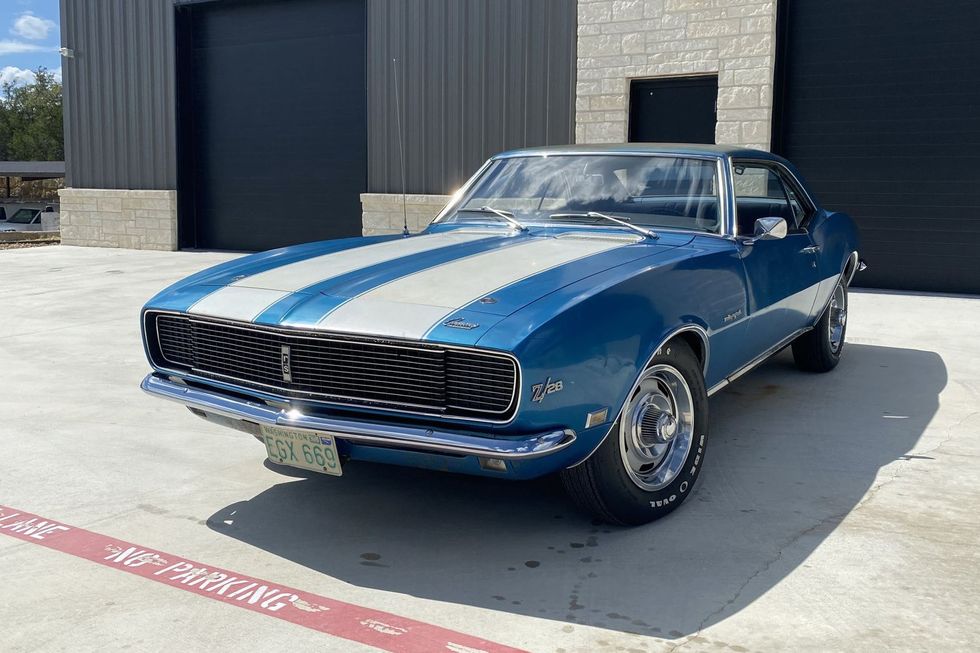
FANCY AN ORIGINAL-CONDITION MUSCLE CAR? THIS 1968 CAMARO Z/28 MIGHT JUST BE YOUR TICKET TO RIDE
When it comes to collecting muscle cars, you pretty much have two paths: modified or original. Take the modified route, and there is no set pattern to what you can do—the sky’s the limit. But go the original route and the path becomes a lot more narrow.
Things like documentation, VIN-stamped engine blocks, factory-installed components and authentic reproductions all matter when it comes to original-spec muscle cars. Presently offered on Hemmings Auctions, this 1968 Chevrolet Camaro Z/28 RS boasts of lots of originality with its seller backing up many of its claims with extensive documentation.The origins of the Z28 option are well known, but here’s a quick recap: In order to race in the Trans-Am series, a car had to be homologated, meaning a minimum of 1,000 examples had to be made with the same powertrain, body and other specifications as would be raced. The Sports Cars Club of America, which sanctioned Trans-Am, followed the FIA’s Group 2 sedan rules, with its local arm, the Automobile Competition Committee for the United States (ACCUS), certifying the homologation.
The Trans-Am spec called for engines up for 5.0 liters in total displacement, which equates to a maximum of 305 cubic inches. Though Chevy did not make a 5.0-liter V8 before 1967, by pairing a 327 block with its 4.00-inch bore with the crankshaft of a 283 and its 3.00-inch stroke, it was able to create an engine with 302 inches of total displacement.
The Z28’s powerplant was not exactly a simple combination of those parts, but wholly engineered for performance. That crank from the 283 wasn’t literally from the 283. While it shared dimensions with the 283’s cast nodular iron crank, the 302’s crank was a stronger forged unit. An aggressive cam, 11.0:1 compression and an 800 cfm Holley four-barrel carburetor were other essential components of the 302, with some period tests of the day noting 7,500 rpm as a “good shift point.” A Muncie four-speed with a heavy-duty clutch and standard 3.71 rear gears rounded out the Z/28’s powertrain.
As a road-racing ringer, the Z/28’s suspension was upgraded with stiffer rear leaf springs than even the big-block 396 cars received. The front end was comparable to a 327-powered Camaro’s setup and front disc brakes were standard fare. Wide E70-15 tires completed the package.
With an engine that many considered underrated at by GM at 290 horsepower, the Z/28 quickly proved its worth on the track, winning the Trans-Am title in 1968 and 1969 with Mark Donohue driving the Penske Racing-prepared cars. Penske Camaros finished first and second in class as well as third and fourth overall at the 1968 Sebring 12 Hours race, an impressive achievement in a field filled with Porches, Corvettes, Ferraris and even Shelby-run Mustangs.
Chevrolet produced an estimated 7,199 Camaro Z/28s for 1968, easily exceeding the minimum homologation requirements. In the 55 years since, few of those Z/28s have remained original. Engines came and went. Accidents, rust, use and abuse changed or eliminated plenty of them. The seller of this 1968 Camaro Z/28 calls it a “time capsule” that had remained in the family of its original owner until 2021.
The physicist who bought it new put it in storage in 1985. After he passed, his son had the car mechanically restored by Renown Auto Restoration in San Antonio, Texas in 2020. The brakes, engine, transmission and rear end were gone through to bring the original-paint Camaro back up to roadworthy condition. Any original parts replaced during the work were kept, such as one of the cylinder heads. The paint itself was left alone, both the Le Mans Blue and contrasting white stripes displaying their decades of patina.
This road-racing-inspired Camaro left the factory rather well equipped, including with the desirable Rally Sport Equipment group, which featured covered headlamps. Other factory-installed options included the deluxe interior, rear window defogger, center console, AM/FM radio and door edge guards.Given the originality claims, the seller backs this Camaro with a sheaf of paperwork, including photos of the partial VIN stamps on the engine block and transmission case which show these components to be factory-installed units. Original purchase and registration documents from its history are also included. The car was even given a thorough inspection and appraisal by noted Camaro expert Jerry MacNeish, who attests to the car’s original paint, interior and other components in the included report. The report does indicate some minor discrepancies from original and by minor we mean such details as “rear spring shackles should be painted semi-gloss black.”
Take a look at this highly original, numbers-matching 1969 Chevrolet Camaro Z/28 RS. Even if you like your first-gen F-bodies modified, this one is worth a visit to Hemmings Auctions.
2023-10-19T18:17:54Z dg43tfdfdgfd